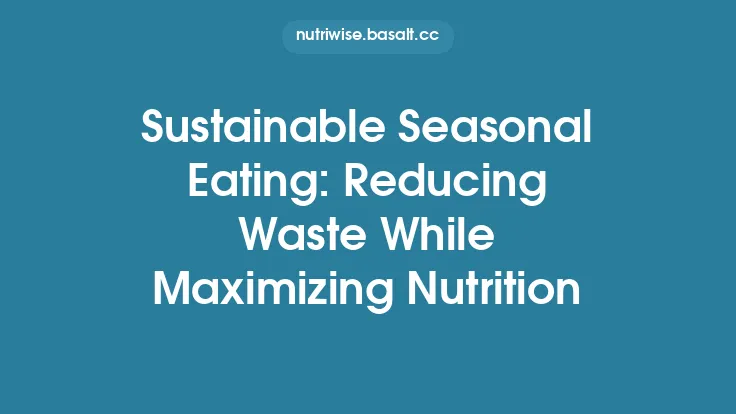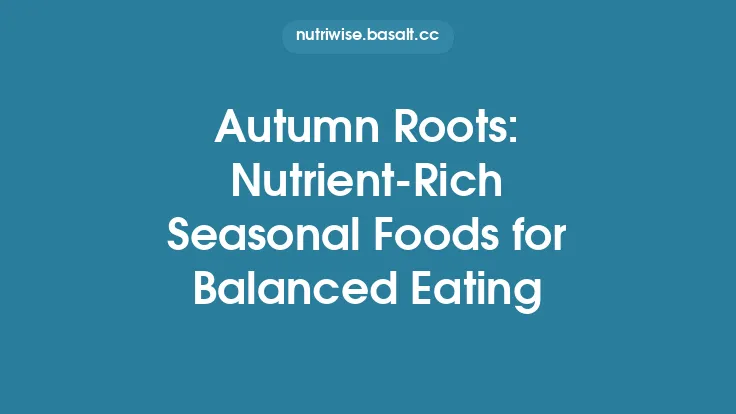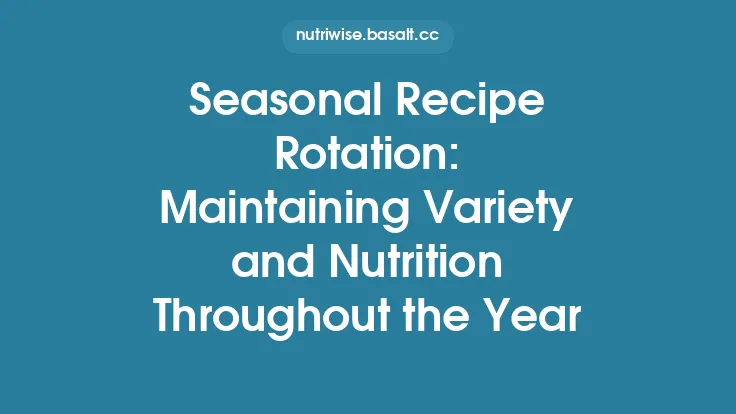Seasonal eating is more than a culinary trend; it is a practice rooted in the natural rhythms of agriculture that delivers tangible health benefits while curbing the environmental toll of our food system. By aligning our plates with what the land produces at any given time, we tap into higher‑quality nutrition and dramatically cut the waste that plagues modern, year‑round supply chains.
Nutrient Density and Freshness
When fruits, vegetables, and other crops are harvested at the peak of their growth cycle, they retain a richer profile of vitamins, minerals, and phytochemicals. The biochemical pathways that generate these compounds—such as flavonoids, carotenoids, and glucosinolates—are most active when plants are allowed to mature fully under optimal seasonal conditions. Harvesting early to meet off‑season demand forces producers to pick produce before these pathways have completed, resulting in lower concentrations of health‑promoting nutrients.
Freshness also matters for bioavailability. Many nutrients, especially water‑soluble vitamins like vitamin C and certain B‑vitamins, degrade quickly once the plant’s cellular structure is broken. Seasonal produce, which typically travels shorter distances and spends less time in refrigerated storage, reaches the consumer with a higher proportion of its original nutrient load intact. This translates into more effective dietary intake without the need for supplementation.
Reduced Energy Use in Production and Distribution
The energy footprint of food is heavily influenced by the length and complexity of its supply chain. Out‑of‑season items often require:
- Climate‑controlled greenhouse production – heating, cooling, and supplemental lighting consume large amounts of electricity or fossil fuels.
- Long‑distance transportation – air freight, refrigerated trucks, and extensive shipping routes increase fuel consumption and greenhouse‑gas emissions.
- Artificial ripening and preservation – chemicals and controlled‑atmosphere storage add further energy demands.
By choosing foods that are naturally in season, we eliminate or drastically reduce these energy‑intensive steps. The crops grow in their native climate, requiring minimal artificial inputs, and they travel only as far as necessary to reach local markets. The cumulative effect is a lower carbon footprint per kilogram of food consumed.
Minimizing Food Waste Through Natural Shelf Life
Seasonal produce typically enjoys a longer, more predictable shelf life because it is harvested at full maturity and handled gently during a short distribution window. In contrast, out‑of‑season items are often harvested immature, then artificially ripened, which can lead to rapid deterioration once they reach the consumer.
When foods stay fresh longer, households and retailers waste less. A study of grocery‑store inventory showed that items sourced seasonally had a 30‑40 % lower rate of spoilage compared with imported, off‑season equivalents. This reduction in waste not only conserves the resources used to produce the food (water, land, labor) but also lessens the volume of organic waste that ends up in landfills, where it would generate methane—a potent greenhouse gas.
Environmental Benefits of Seasonal Consumption
Beyond energy savings, seasonal eating supports broader ecological health:
- Soil Conservation – Rotating crops according to seasonal suitability helps maintain soil structure and reduces the need for synthetic fertilizers.
- Biodiversity Preservation – Seasonal planting encourages a diversity of species, which in turn supports pollinators and natural pest control.
- Water Efficiency – Crops grown in their natural climate require less irrigation, easing pressure on local water supplies.
These practices collectively foster resilient agro‑ecosystems that can better withstand climate variability and reduce the need for intensive, environmentally damaging interventions.
Economic Advantages of Seasonal Choices
When demand aligns with natural supply, market prices tend to stabilize at lower levels. Seasonal abundance drives competition among growers, which can translate into more affordable produce for consumers. Moreover, reduced reliance on energy‑intensive greenhouse operations and long‑haul logistics cuts production costs, savings that can be passed down the supply chain.
For producers, focusing on seasonal crops reduces the financial risk associated with off‑season production, such as the high capital outlay for climate control infrastructure. This can lead to more sustainable business models and a healthier local economy.
Long‑Term Health Implications
Consistently consuming a diet rich in seasonally available foods encourages variety, as the roster of fruits and vegetables changes throughout the year. This dietary diversity ensures exposure to a broad spectrum of micronutrients and bioactive compounds, which research links to lower incidences of chronic diseases such as cardiovascular disease, certain cancers, and metabolic disorders.
Furthermore, the higher nutrient density of seasonal produce can improve satiety and support better weight management, reducing the reliance on processed, nutrient‑poor foods that dominate many modern diets.
Integrating Seasonal Foods into Everyday Life
Embracing seasonal eating does not require a complete overhaul of one’s kitchen. Simple, sustainable habits can make a substantial difference:
- Observe Local Harvest Patterns – Even without a formal calendar, paying attention to what appears in farmers’ markets, grocery aisles, and community-supported agriculture (CSA) boxes provides a practical guide to what’s in season.
- Plan Around Peak Availability – Base weekly grocery lists on the freshest options, allowing flexibility to substitute similar items when a particular fruit or vegetable is at its peak.
- Utilize Whole Produce – Incorporate stems, leaves, and skins that are often discarded but are edible and nutrient‑rich, thereby extending the usable portion of each item.
- Store Appropriately – While detailed preservation techniques are beyond the scope here, basic practices such as keeping produce in breathable containers and using the refrigerator judiciously can prolong freshness without extensive processing.
By making these modest adjustments, individuals can reap the nutritional and environmental rewards of seasonal eating without feeling constrained.
A Sustainable Outlook
Seasonal eating sits at the intersection of personal health and planetary stewardship. It leverages the natural timing of agricultural cycles to deliver foods that are nutritionally superior, energetically efficient, and less prone to waste. As climate change intensifies and resource constraints tighten, aligning our consumption patterns with the seasons becomes not just a preference but a pragmatic strategy for a resilient food future.





